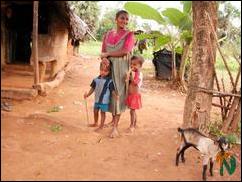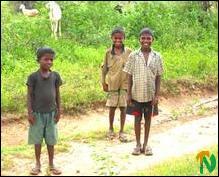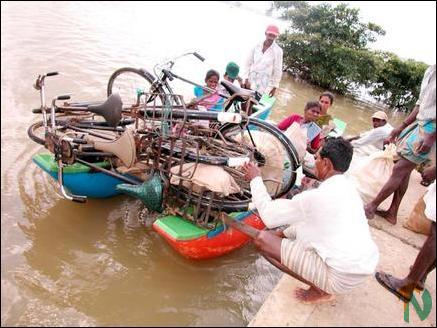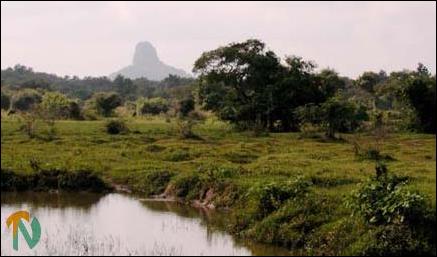
Rising from the shambles of a counter insurgency campaign
[TamilNet, Thursday, 13 February 2003, 18:01 GMT]
The large Vadamunai-Tharavai region, northwest of Batticaloa, is struggling to rise out of the havoc wreaked by one of the most sustained text book counter insurgency campaigns waged by the Sri Lanka army. A few hundred of the thousands of families which were driven out of their villages by the SLA more than 12 years ago have begun venturing back to their homesteads and lands here. But there are no schools for their children, no medical facilities for the sick, no transport, no sanitation and no basic amenities in any of the villages in the region.
These were either deliberately destroyed by the SLA to deter people from resettling or were completely ruined by more than a decade of neglect and the relentless tide of the dry zone jungle.
 |
Parvathy and her sons in Koolavadi
Click on the image for an enlarged version |
"My children went briefly to a kindergarten here. It was the only school in these parts. It was shut down recently because the organisation that opened it stopped paying the teacher her salary. Children here herd the goats. The older ones work in the fields too", said Subramaniam Parvathy, who runs a small tea shop in Koolavadi, a village by the dilapidated gravel road that winds through the region to Vadamunai, the village from which the region gets its name.
"We had no time to collect our belongings. We ran for our lives when the army moved in. The soldiers set fire to our homes and fields, slaughtered our cattle and goats. The fires destroyed all the rice we harvested that season", said Shanmugapodi Yogendran, 32, in Vellamaichenai.
He and his young wife have built a small hut in their field. Their rice crop is ruined by a deadly pest, locally known as "Arakkotti".
"We couldn't afford the pesticide", laments Shanmugapodi.
"The fields are not level. Bombs dropped by the air force have left craters and upset the 'soil balance' which can be achieved in paddy fields only through years of levelling and irrigation. The soil has also been poisoned by chemicals from shells fired by the Sri Lanka army", he said.
The region used to be heavily bombed by the Sri Lanka Air Force on a regular basis before Colombo signed the ceasefire agreement with the LTTE last year.
 |
Goat herding boys on the road near Koolavadi
Click on the image for an enlarged version |
The SLA claimed that the Tigers had a large military base near Kudumbimalai, a hat shaped hill in the middle of the Vadamunai region.
Eighteen stray cattle were killed in the SLAF's last bombing raid on the environs of Kudumbimalai.
In the past, SLA and the military trained Police encamped by the district's main coastal road were in the habit of opening fire with mortars and medium artillery on randomly selected points in the region in retaliation to LTTE attacks in areas controlled by them.
However, one sees few indications of the LTTE's military presence in the region, except a post at Pulipainthakal (which in Tamil means 'the rock from which the Tiger pounced'), a junction at the entrance to the Vadamunai-Tharavai region, about 3 kilometres west of Kiran. There is also the sprawling LTTE war memorial and cemetery in Tharavai.
The SLA has a camp and an entry point across the river, guarding the bridge on it. Heavy rains in the jungle last week have swelled the waters of Maandharai Aaru (called Maduru Oya in modern maps of Sri Lanka) which have smashed through the dilapidated causeway at two points between Kiran Bridge and Pulipainthakal.
 Readying for the crossing from Kiran
Readying for the crossing from Kiran
Click on the image for an enlarged versionPeople have to now make it by canoe across the dangerously swirling waters of the Maandharai River in monsoon spate. An LTTE cadre was killed recently while trying to cross a point which the floods have broken through.
But the floods have done little to deter people from travelling to and fro. It is harvest time and many are looking forward to a good crop this year, after more than a decade of semi destitution. Tipplers are also at hand among those making the hazardous trip. Their mirthful chatter, lightening the gloom of the floods, is a sign of the times, says the boatman.
The region's lands are very fertile, surrounded by large swathes of virgin forest.
Nallathamby Thavarajah, 48, Shanmugapodi's father in law who cultivates a large plot of high and low land nearby they have to clear and prepare new land to get better yields from cash crops and paddy.
Thavarajah, like many others in the Vellanaichenai area, is from the village of Sitthaandy, 22 kilometres north of Batticaloa, on the district's main coastal trunk road. Orphaned as child, a family from Jaffna had taken him to work at rice mill there at the age of seven.
"I spent my teenage working in that mill and came back to Batticaloa when I was an adult", he said.
Thavarajah married a woman from one of the traditional Tamil villages near Polannaruwa.
The Mattakalappu Poorva Sariththiram, a medieval historical text, says that the Chola king settled soldiers in Muththukkal, one of the main villages which lie on the Polannaruwa city's periphery, close to the Mahaweli Ganga.
Polannaruwa was the fortress capital of the island when Sri Lanka was a province of the Chola Empire.
 A view of the Kudumbimalai hill
A view of the Kudumbimalai hill
Click on the image for an enlarged versionThe SLA and Police have been engaged in ethnic cleansing in the Tamil villages here for almost two decades. But the Tamil population has persisted, refusing to flee en masse to escape the terror of the 'cleansing'.
"There are lots of widows in my wife's village. The SLA killed Tamil males in her village one by one. Sinhala settlers were encouraged to encroach on our lands with impunity. That's why we decided to settle here permanently, leaving behind valuable property and fields which belonged to my wife's family", Thavarajah said.
"I first settled in Vadamunai. But few years later we had to flee from there when thousands of Singhalese were brought in almost overnight by the government to be settled in Vadamunai", he says.
The UNP government tried to settle thousands of Singhalese in the Vadamunai-Tharavai region in 1984. Tamils were chased out of their villages as more than ten thousand Sinhala settlers were moved overnight by the Ministry of Mahaweli Development to occupy key positions in the region. The Sri Lankan government has earmarked the Vadamunai-Tharavai as System B of the Mahaweli Irrigation Scheme.
The Sri Lankan government at the time encouraged the scheme to flood System B with Sinhala settlers to drive a wedge between northern and southern parts of the Batticaloa district in the manner that the SLA‚s Manalaaru (Weli Oya) settlement had severed the ethnic contiguity of the east coast by creating a Sinhala enclave as a wedge between the Trincomalee and Mullaithivu districts.
Batticaloa survived the catastrophe because adverse publicity in the Tamil press spurred the Canadian government, one of the main sources of funds for System B, to caution Colombo into withdrawing explicit support for the Sinhala settlers and due to the efforts of local university students and social activists.
Later forays into the region on a smaller scale were thwarted by the growth of the armed Tamil movement in the district.
Today, scores of villages such as Vadamunai and Ootruchenai lie in ruins, swamped into oblivion by the relentless tide of the dry zone jungle.
"We are making an effort", says a government official in Batticaloa in charge of rehabilitation. "But it is a drop in the ocean, considering the enormity of the task ahead of us here", he added.
"No major NGO, not even the Tamil Rehabilitation Organisation (TRO), has made any significant effort so far to improve the lot of the people in this important region", a social activist in Batticaloa said.
Related Articles:08.11.02
Refugees eager to resettle, demand basic facilities 21.03.02
Four thousand demonstrate against SLA in east 26.05.99
Forced labour said exacerbating poverty










